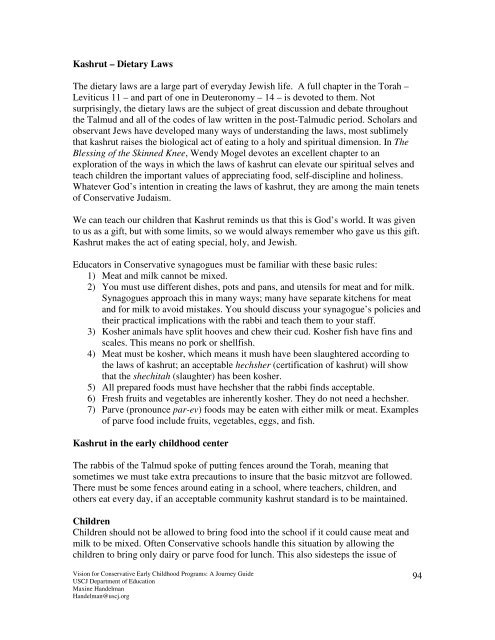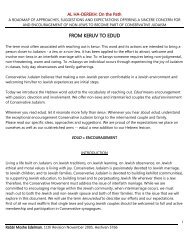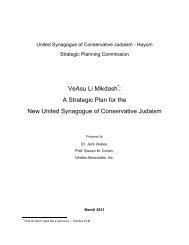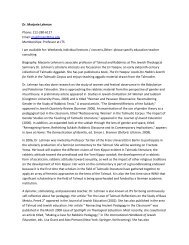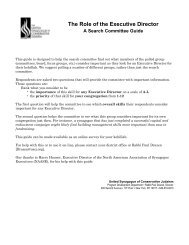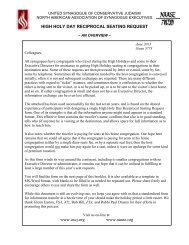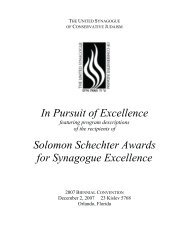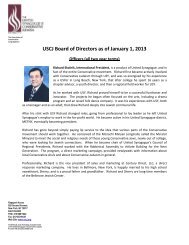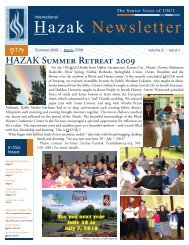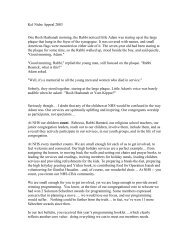Vision for Conservative Early Childhood Programs: A Journey Guide
Vision for Conservative Early Childhood Programs: A Journey Guide
Vision for Conservative Early Childhood Programs: A Journey Guide
Create successful ePaper yourself
Turn your PDF publications into a flip-book with our unique Google optimized e-Paper software.
Kashrut – Dietary Laws<br />
The dietary laws are a large part of everyday Jewish life. A full chapter in the Torah –<br />
Leviticus 11 – and part of one in Deuteronomy – 14 – is devoted to them. Not<br />
surprisingly, the dietary laws are the subject of great discussion and debate throughout<br />
the Talmud and all of the codes of law written in the post-Talmudic period. Scholars and<br />
observant Jews have developed many ways of understanding the laws, most sublimely<br />
that kashrut raises the biological act of eating to a holy and spiritual dimension. In The<br />
Blessing of the Skinned Knee, Wendy Mogel devotes an excellent chapter to an<br />
exploration of the ways in which the laws of kashrut can elevate our spiritual selves and<br />
teach children the important values of appreciating food, self-discipline and holiness.<br />
Whatever God’s intention in creating the laws of kashrut, they are among the main tenets<br />
of <strong>Conservative</strong> Judaism.<br />
We can teach our children that Kashrut reminds us that this is God’s world. It was given<br />
to us as a gift, but with some limits, so we would always remember who gave us this gift.<br />
Kashrut makes the act of eating special, holy, and Jewish.<br />
Educators in <strong>Conservative</strong> synagogues must be familiar with these basic rules:<br />
1) Meat and milk cannot be mixed.<br />
2) You must use different dishes, pots and pans, and utensils <strong>for</strong> meat and <strong>for</strong> milk.<br />
Synagogues approach this in many ways; many have separate kitchens <strong>for</strong> meat<br />
and <strong>for</strong> milk to avoid mistakes. You should discuss your synagogue’s policies and<br />
their practical implications with the rabbi and teach them to your staff.<br />
3) Kosher animals have split hooves and chew their cud. Kosher fish have fins and<br />
scales. This means no pork or shellfish.<br />
4) Meat must be kosher, which means it mush have been slaughtered according to<br />
the laws of kashrut; an acceptable hechsher (certification of kashrut) will show<br />
that the shechitah (slaughter) has been kosher.<br />
5) All prepared foods must have hechsher that the rabbi finds acceptable.<br />
6) Fresh fruits and vegetables are inherently kosher. They do not need a hechsher.<br />
7) Parve (pronounce par-ev) foods may be eaten with either milk or meat. Examples<br />
of parve food include fruits, vegetables, eggs, and fish.<br />
Kashrut in the early childhood center<br />
The rabbis of the Talmud spoke of putting fences around the Torah, meaning that<br />
sometimes we must take extra precautions to insure that the basic mitzvot are followed.<br />
There must be some fences around eating in a school, where teachers, children, and<br />
others eat every day, if an acceptable community kashrut standard is to be maintained.<br />
Children<br />
Children should not be allowed to bring food into the school if it could cause meat and<br />
milk to be mixed. Often <strong>Conservative</strong> schools handle this situation by allowing the<br />
children to bring only dairy or parve food <strong>for</strong> lunch. This also sidesteps the issue of<br />
<strong>Vision</strong> <strong>for</strong> <strong>Conservative</strong> <strong>Early</strong> <strong>Childhood</strong> <strong>Programs</strong>: A <strong>Journey</strong> <strong>Guide</strong><br />
USCJ Department of Education<br />
Maxine Handelman<br />
Handelman@uscj.org<br />
94


